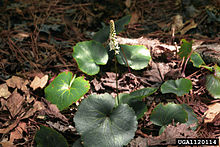Galax
| Galax | |
|---|---|

| |
| Scientific classification | |
| Kingdom: | Plantae |
| Clade: | Tracheophytes |
| Clade: | Angiosperms |
| Clade: | Eudicots |
| Clade: | Asterids |
| Order: | Ericales |
| Family: | Diapensiaceae |
| Genus: | Galax Sims |
| Species: | G. urceolata
|
| Binomial name | |
| Galax urceolata | |
Galax, the wandplant, wandflower, or beetleweed, is a genus in the
Description
It is an
Taxonomy
The genus name Galax comes from the Greek word "gala" which means "milk",[4] describing Galax's white flowers.
Around 1730, Galax was collected by John Clayton, due to his friendship with Mark Catesby, an English naturalist who had just arrived in Virginia. Based on Catesby's recommendation, Clayton ended up sending his specimens to Jan Frederik Gronovius, a Dutch botanist.[5] In 1739, Gronovius published The Flora of Virginia, where "Anonymos or Belvedere" is the plant long known as Galax aphylla. Clayton provided Gronovius with four samples, all which were destroyed in a series of unfortunate events.[5]
Many years later,
Between March 1803 and September 1804, Galax was rediscovered and renamed five times. Any time the new name referred to Mitchell's description, it was invalidated. The name that is considered valid, since it pre-dates all other names and follows the rules of nomenclature, was Pyrola urceolata Poir., named by
The type specimen was collected by
| Name | Authority | Date | Description |
|---|---|---|---|
| Erythrorhiza rotundifolia | André Michaux | March 1803 | Noted as a synonym of Galax aphylla Linn. therefore invalidated. |
| Pyrola urceolata | Jean Louis Marie Poiret | January 1804 | Based on a plant in cultivation in France, in the garden of M. Lemonier. |
| Blandfordia cordata | Henry C. Andrews | February 1804 | Blandfordia was used for a genus in Liliaceae in 12/1804, and the genus name is still conserved. This name is therefore invalidated. |
| Galax aphylla | John Sims | June 1804 | Stated synonymy with Erythrorhiza rotundifolia of Michaux, Blandfordia cordata of Andrews, Belvedere of Clayton & Gronovius, Viticella of Mitchell, and Pyrola from Poiret. - invalidated |
| Solenandria cordifolia | E. P. Ventenat | September 1804 | Pointed out that Belvedere of Clayton & Gronovius and Viticella of Mitchell were not the same plant. |
Uses
The leaves are often harvested for the
The independent city of Galax, Virginia, is named after this plant.
References
- ISBN 978-0-231-89916-1.
- S2CID 52310009.
- S2CID 89816057.
- ^ Predny, Mary Lorraine (2005). Galax (Galax Urceolata): An Annotated Bibliography. U.S. Department of Agriculture, Forest Service, Southern Research Station ; [Washington, D.C.?].
- ^ JSTOR 1218202.
External links
- Plants for a Future: Galax urceolata
- Galax (Galax urceolata): an annotated bibliography USDA Southern Research Station, 2005.
- photo of Galax urceolata at flickr.com
